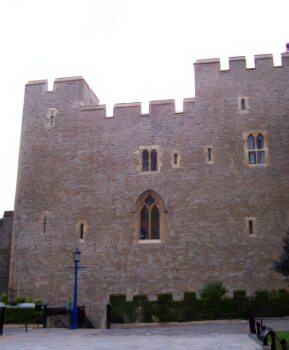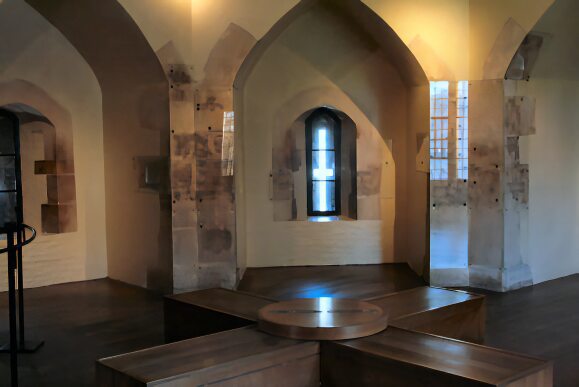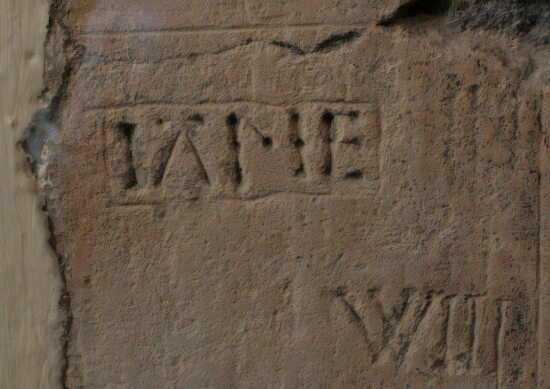Tower of London
The Beauchamp Tower forms part of the inner defensive wall and was built between 1275 - 1281 by King Edward I. It replaced a twin-towered gatehouse on the site which had been built by his father, King Henry III. The tower is built mostly of brick, but faced externally with stone and was so named after its first prisoner Thomas Beauchamp, Earl of Warwick. The Earl of Warwick was attainted by Richard II in 1397.
The Beauchamp Tower
Throughout its long history the Beauchamp Tower has been used on and off to house high ranking prisoners. Its large size and close location to the Lieutenant's Lodgings, now the Queen's House, made the Beauchamp Tower perfect for housing important prisoners. Lady Jane Rochford, lady-in-waiting to Queen Catherine Howard, the fifth wife of King Henry VIII, was interogated in the Beauchamp Tower prior to the Queen's trial. Lady Rochford's confession within its walls was instrumental in bringing about the tragic death of Catherine Howard. Her interrogation was said to have driven her insane, the terrified Lady Rochford was beheaded on nearby Tower Green on the same day as Queen Catherine on 13th February, 1542.
The Beauchamp Tower is most famous for its graffiti, which was carved between the sixteenth and seventeenth centuries, a period of religious and political upheaval when the Tower of London became the country's foremost state prison. Amongst many inscriptions to be found on its walls is one to the tragic Lady Jane Grey, nine days Queen of England. From her window near the Queen's House in the Tower, on 12th February 1554, the seventeen-year-old Lady Jane watched her young husband go from the Beauchamp Tower to his execution on Tower Hill and saw his bleeding headless body carried back for burial at the Tower Chapel of St. Peter ad Vincula. She was executed later the same day.
The most elaborate inscription is a memorial to the five Dudley brothers, who were imprisoned in the Beauchamp Tower, one of whom was Lord Guilford Dudley, husband of Lady Jane Grey. The flowers around the Dudley family arms represent the names of the four brothers who were imprisoned in the Tower between 1553-4, as a result of the attempt by their father to put Lady Jane Grey upon the throne. The roses are for Ambrose, carnations (known as gillyflowers) for Guildford, oak leaves for Robert, from robur, Latin for oak, and honeysuckle for Henry. All four were condemned as traitors in 1553, but after the execution of Guildford, they were pardoned and released.
Beauchamp Tower Interior
Before his execution, Guildford Dudley asked his wife Lady Jane Grey, also imprisoned in the tower, for a last meeting. Jane refused, explaining it "would only ... increase their misery and pain, it was better to put it off ... as they would meet shortly elsewhere, and live bound by indissoluble ties." About ten o'clock in the morning of 12 February Guildford was led from the Beauchamp Tower, out of the Tower and up to Tower Hill for his execution, where "many ... gentlemen" waited to shake his hand. He made a short speech to the assembled crowd, as was customary. He then knelt and prayed, asking those present to pray for him, "holding up his eyes and hands to God many times", he was dispatched with one stroke of the axe, after which his body was taken on a cart, his head in a cloth, to the Chapel of St Peter ad Vincula. Watching the sad spectacle from her window, Jane exclaimed: "Oh, Guildford, Guildford! O the bitterness of death". He was interred in the chapel along with Jane who was executed shortly after him on the same spot on Tower Green as Anne Boleyn, the countess of Salisbury and Queen Catherine Howard.
Memorial graffiti in the Beauchamp Tower commemorating Lady Jane Grey, the nine days queen
The Victorian architect Anthony Salvin was appointed in 1851 to 'restore' the Tower to a pseudo-medieval form so it could be opened to the public. He repaired doors and windows, recreated the battlements and improved the outside facade.
The Medieval Palace PreviousNext The Byward Tower
